Looking for effective ways to manage your organization’s IT assets? IT asset management (ITAM) software tools can help streamline inventory tracking, software licensing, and compliance management. In this article, we’ll review the eight best ITAM software tools available to improve your IT asset management practices.
Asset management in IT – ITAM
What Is ITAM?
Finding the Right Tool
The List: 8 Best Asset Management Software
- SolarWinds Web Help Desk (our pick)
- SolarWinds Service Desk (our pick)
- ManageEngine AssetExplorer
- Alloy Navigator Enterprise
- LANsweeper
- SysAid</span
- InvGate Assets
- Spiceworks IT Asset Management
Conclusion: The Best Asset Management Software
Asset management in IT – ITAM
Asset management in IT teams is mostly about keeping track of the physical hardware that comprises your infrastructure and keeping tabs on mobile devices and virtual machines. In recent years, IT asset management (ITAM) has grown to include software licenses and cloud subscriptions, so organizations can gain a complete overview of everything they own or have invested in as part of their IT infrastructure.
Whether your business assets take the form of photocopiers and printers, company cars, or computer chairs, these things all need to be recorded as part of the procurement, facilities management, and accounting processes. This recording used to be done manually using spreadsheets, but now tools and software programs can simplify this and get the job done faster and with less stress.
What Is ITAM?
IT asset management is fundamentally a business management practice. It involves a complete and ongoing review of all the assets in a business’s inventory and decisions related to sourcing and use. IT equipment and licenses can be expensive, and ITAM is essentially the process of ensuring the IT team and its equipment are managed well and kept within a reasonable budget.
Most ITAM software is designed around asset life cycles, including:
- planning and acquisition
- deployment
- usage
- maintenance or upgrades
- end-of-life decommissioning
- retirement.
Appropriately dealing with ITAM gives you visibility and proper control over IT assets, helping ensure IT team budgets stay within scope. With ITAM, you know whether you’re under or over capacity in terms of equipment based on your needs. You can also improve the utilization of your assets by keeping a close eye on what you have, looking at how everything is used, and upgrading or selling equipment when it makes sense to do so. In undertaking these measures, businesses can potentially reduce their hardware and software budgets, by removing unnecessary items or declining to renew an underperforming piece of software for the following year.
ITAM processes also play a role in compliance measures, including those for audit and regulatory requirements. When an audit or regulatory review comes up, ITAM tools and records can be used to show appropriate assets are in place to keep data secure, information security measures are functioning, and the business is expanding its capacity to promote stability, performance, and safety for key data.
Finally, the data gained through ITAM processes can be used by finance and accounting teams to separate out project costs on a per-team basis, and to align the costs of IT assets to the services provided. This leads to better budgeting and greater financial accountability, which can help promote financial certainty within your organization. ITAM is part of the larger process of IT service management (ITSM), which is the process of creating or designing, managing, delivering, and supporting IT services for the wider business.
Finding the Right Tool
Many pieces of software targeting ITAM have multiple primary functions, such as IT help desk support alongside asset management. Often, IT teams will need to troubleshoot issues for end users; they may also need to look at inventories to assign another resource, check when a software license is going to expire, or determine if a piece of hardware is at the end of its life. 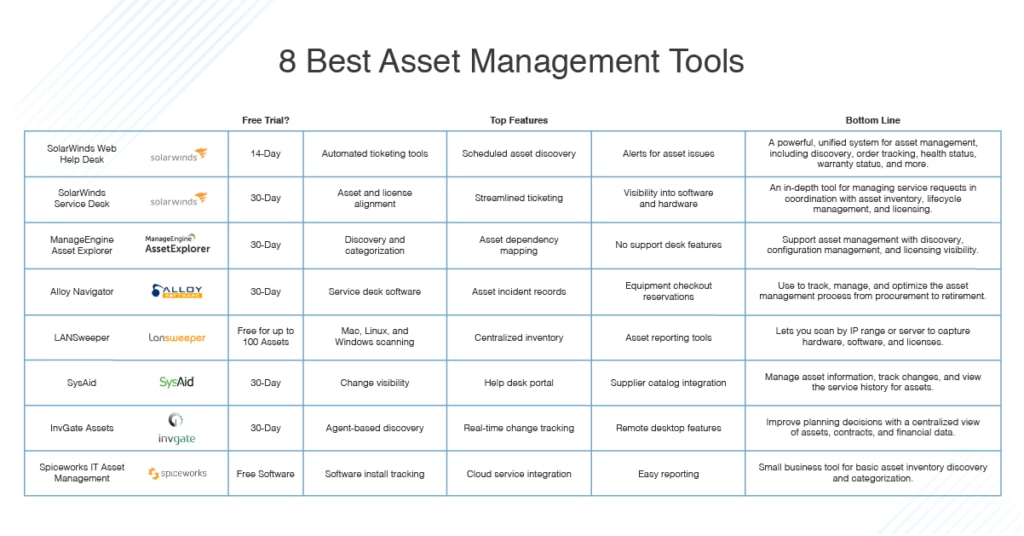 © 2020 SolarWinds Worldwide, LLC. All rights reserved.
© 2020 SolarWinds Worldwide, LLC. All rights reserved.
Many tools also include broader toolsets, such as network monitoring, server and application monitoring, and Wi-Fi scanning and optimization tools. Some of these come as separate tools that can connect with each other, while others work as part of a larger platform. When considering what’s right for your organization, you need to consider the tools you have, budget, scope, and capacity.
There’s no sense purchasing tools with a capacity far greater than what you actually need, as this excess capacity will go unused and you’ll end up paying more than is necessary. You also need to consider whether you’re looking for a one-off purchase or an ongoing subscription with, for example, monthly support.
Consider the strengths of each tool, and then compare it to what you care about most in your business. For example, if a tool has great help desk capabilities but what you really care about is asset security management, you may need to look at a different tool. And if you want help desk and ticketing systems alongside asset management and network optimization, you’re not likely to want a tool with great network management features but few ticketing and service utilities.
The List: 8 Best Asset Management Software
There are several asset management solutions on the market today. Some balance IT asset management tools and help desk tools, while others serve as standalone software asset management tools. The products listed below all have their own strengths. After determining which might be right for your enterprise, check out a free trial as available.
1. SolarWinds Web Help Desk (Free trial)
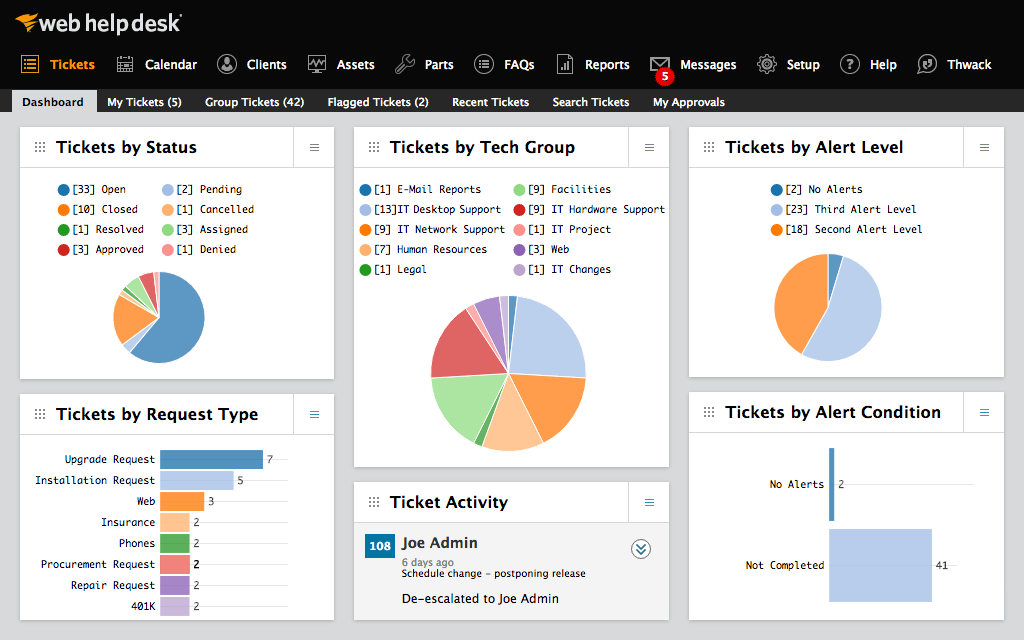 © 2020 SolarWinds Worldwide, LLC. All rights reserved.
© 2020 SolarWinds Worldwide, LLC. All rights reserved.
SolarWinds Web Help Desk (WHD) is one of my top tools in this category, as it has a huge number of features to help with asset management and broader tools for troubleshooting, ticketing, and assisting end users. WHD includes a unified system for:
- ticketing
- asset management
- change management
- and knowledge management
which makes it a one-stop shop for IT teams to perform their front-line and infrastructure management tasks.
On the help desk side, the ticketing management tools WHD comes with are highly automated, helping you avoid errors without needing to go through tedious manual processes. You can easily create tickets, assign them to support team members, and route and escalate them as necessary. You can also easily link service requests to each other when they relate to the same IT project, or when multiple tickets are all coming through for one issue. This can help to keep the resolution process from becoming chaotic and messy.
WHD also includes many tools designed to help IT teams to manage hardware and software assets and gain visibility and control over infrastructure. For example, it includes tools for asset discovery, inventory maintenance, and reporting. You can discover systems based on subnet or IP range, and you can schedule discovery processes to check inventory regularly.
The tool can gather a large amount of information about each device it discovers; it then puts this information into a centralized repository of asset details. You can even link these asset details to service requests, so you can see which assets have a long history of service requests and issues.
In addition, WHD allows you to schedule checkup times for assets, to keep an eye on which assets have been recently examined for problems and which haven’t. The alert system includes the ability to let you know if an asset hasn’t been delivered or has gone missing. Purchase orders, part orders, and billing processes for assets can also be managed through WHD. Asset reports can be produced to display asset status, health, and purchase and warranty status and to identify problematic assets or any with expiring warranties.
You can integrate WHD with other SolarWinds tools, such as SolarWinds Network Performance Monitor, SolarWinds Server & Application Monitor, and Dameware® Remote Support software. By linking it in with these tools, you can build a comprehensive IT support and management solution. WHD offers a free trial for up to 14 days, available through the SolarWinds website.
2. SolarWinds Service Desk (Free trial)
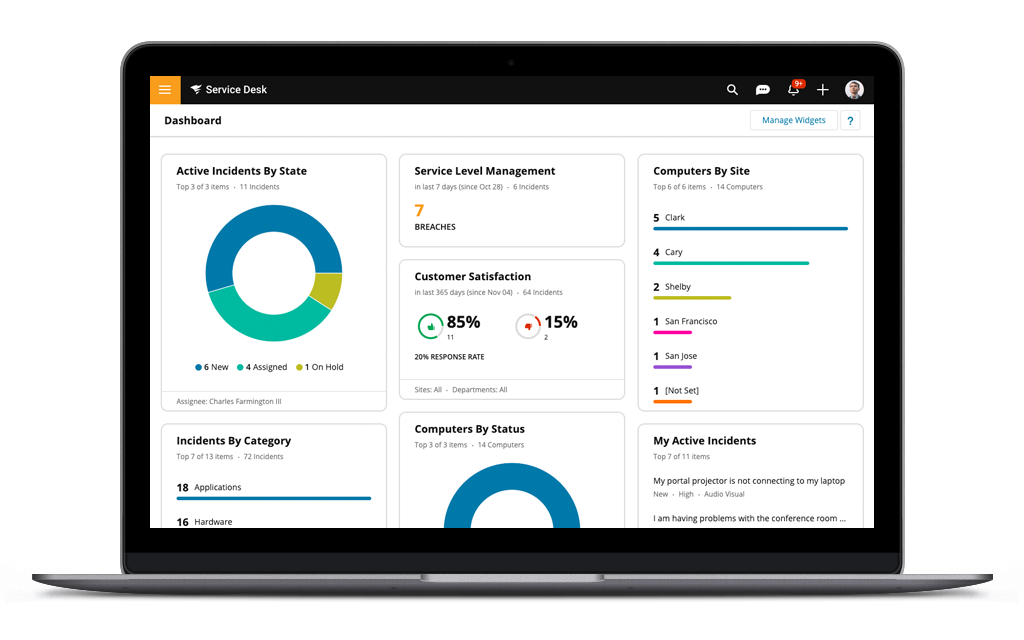 © 2020 SolarWinds Worldwide, LLC. All rights reserved.
© 2020 SolarWinds Worldwide, LLC. All rights reserved.
Another useful piece of software from SolarWinds, Service Desk is an ITSM tool designed to help businesses manage employee services and service requests alongside incident and asset management. For comparison, WHD (reviewed above) is an on-premises model, while Service Desk follows a SaaS model.
Service Desk is a cloud-based offering that provides tools for dealing with change management and ITIL services. Regarding asset management, Service Desk has tools for you to visualize the entire lifecycle for each of your assets and consolidate your asset information in one place. It includes risk-detection tools as a part of this, showing you which of your software licenses are in active use out of those your organization has purchased but is not using. You can easily align your contracts and licenses with your physical and software assets, to keep a record of expiration dates, asset lifecycles, and renewal dates.
Service Desk encompasses service management tools, including tools for ticket routing, identification of priority issues, and ticket automation. Using SolarWinds Service Desk, you can assign categories and subcategories to tickets to support faster resolution of issues based on priority and need. Tickets can be collected via email, phone, or walk-in, and requests are integrated in one place, providing complete visibility. “Smart suggestions” help streamline the process of ticketing by assisting end users in making their requests in the clearest, most effective way.
Like SolarWinds WHD, Service Desk comes with a free trial, available through the SolarWinds website and good for up to 30 days.
3. ManageEngine AssetExplorer
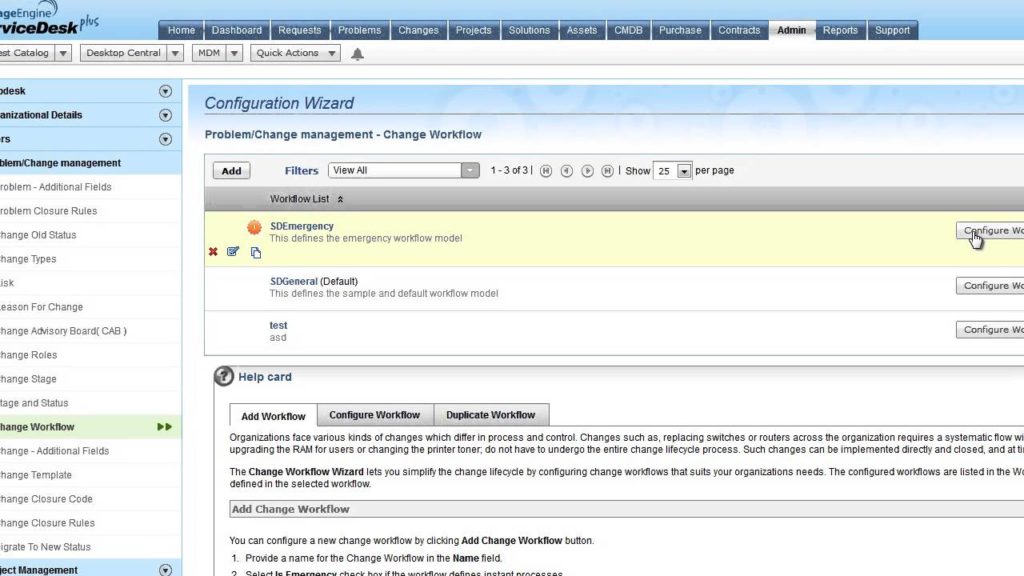 © 2020 ManageEngine. All rights reserved.
© 2020 ManageEngine. All rights reserved.
Another useful tool is ManageEngine AssetExplorer. This is primarily an asset management software and doesn’t offer support desk or ticketing tools. It can manage your assets from the planning phase through end of life.
AssetExplorer includes robust asset discovery tools, to help ensure your hardware and software assets are discovered and monitored. Once it has completed the discovery process, it groups your assets into categories, which include IT assets and non-IT assets, asset components, and software. You can also organize assets on your own by product type or product name, and can add details to these lists, including information on price, vendor, and warranty period.
Additionally, using the tool’s configuration management database feature, you can map the relationships between your various assets. This allows you to easily determine dependencies and keep infrastructure stable when you need to make a change or go through the troubleshooting process. When it comes to software assets, AssetExplorer provides complete visibility into your software licenses. It provides information on the number of licenses purchased, installations, and remaining licenses for which software has not been installed. It can also detect unlicensed and illegal software, which can help flag security threats your network may have been exposed to.
The remote control tools in AssetExplorer enable you to take control of assets and manage them from afar, which can greatly improve your ability to perform maintenance as needed. Finally, the software can generate comprehensive reports on custom or predefined metrics, and it gives you the ability to regularly schedule reports to help ensure you stay up to date. AssetExplorer offers a free version that limits users to 25 nodes. You can also access a 30-day free trial of the professional version, which is restricted to 250 nodes.
4. Alloy Navigator Enterprise
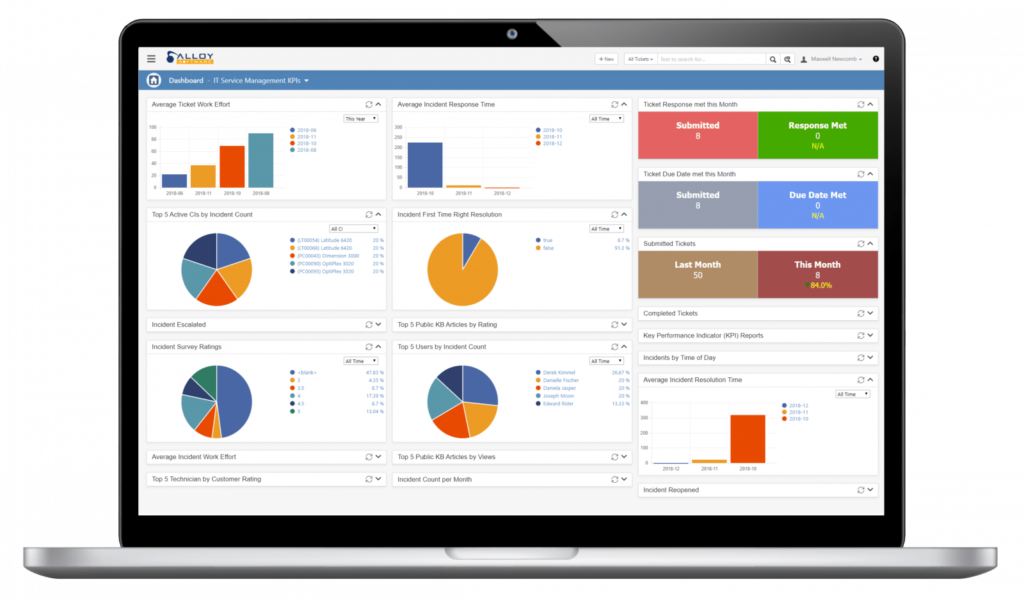 © 2020 Alloy Navigator Enterprise. All rights reserved.
© 2020 Alloy Navigator Enterprise. All rights reserved.
Like SolarWinds WHD and Service Desk, Alloy Navigator Enterprise is an IT service desk tool with asset tracking software. You can use Alloy Navigator to track, manage, and optimize the asset management process from procurement to retirement, and improve decision making by gaining a better understanding of your IT environment and assets. A good portion of the asset management process can be automated with Alloy Navigator, which takes pressure off your day-to-day IT tasks.
Alloy Navigator includes tools to reclaim unused software licenses, so you aren’t spending more money than you need to. It can also help you to detect auto-renewals and cancel them when necessary, preventing you from paying for renewals of software you don’t want anymore.
Furthermore, Alloy Navigator helps you manage your software licenses in line with compliance requirements, so you can avoid violations or other issues. Each asset can be examined for its incident history and maintenance records. This can help you spot faulty assets and opportunities to try a different piece of software if something you’re using is resulting in a lot of ticketing requests. It can also yield information on warranty contracts, so you can compare incident history with warranties, and contact manufacturers if a problem has arisen within the warranty period and conditions.
Alloy Navigator can facilitate equipment management and checkout, and users can reserve equipment through the Self-Service Portal. Email notifications let users know when they need to return equipment, and usage is tracked to ensure assets get returned. Like AssetExplorer, Alloy Navigator includes a configuration management database to provide visibility into the relationships between various assets. A free demo of Alloy Navigator Enterprise is available on request.
5. LANsweeper
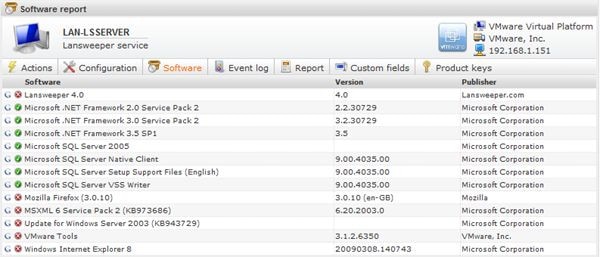
© 2020 LANsweeper. All rights reserved.
LANsweeper is an asset discovery and management tool that allows you to discover the assets in your network without needing to install software on your machines. It scans your network to find information about your assets, determining hardware specs and showing you what software is installed, along with the user details. In the discovery process it can scan Mac, Linux, and Windows devices. You can also set it up to track assets not yet connected to the network or were previously connected and are now disconnected.
LANsweeper develops and maintains a centralized inventory for your assets, regardless of whether they’re software, hardware, or user assets. The inventory provides information on which assets your organization owns, where they’re located, which users have access to them, and who’s currently using them. With a centralized inventory, you can see everything easily in one view, giving a comprehensive picture of your IT environment at a glance.
To collect information on hardware assets, you can set up LANsweeper to scan by IP range, or set servers to be scanned. It collects details on computers and their components, and you can set it up to scan your network regularly, automating the process as much as possible. For each device, it can collect information about the:
- processor
- graphics card
- motherboard
- manufacturer
- serial number
- and so on.
You can then produce hardware reports based on this information, organized by device type, manufacturer, or amount of memory, among other categories.
LANsweeper can identify software installed on each device and provide you with email alerts when new software is installed. As with hardware assets, LANsweeper will inventory your software assets, scanning either regularly or as needed. You can also mark unauthorized software if you want to clear it from usage or flag it for additional security screening. Furthermore, LANsweeper scans for licenses and helps you manage license compliance for IT auditing purposes. It can scan to determine the quantity of each license item your business owns. It can then compare this with the number of licenses your business owns, to help determine if you’re over- or under-subscribed.
You can try LANsweeper for free for up to 100 assets. For unlimited assets, you can purchase the Enterprise version. Demos are available on the LANsweeper website.
6. SysAid
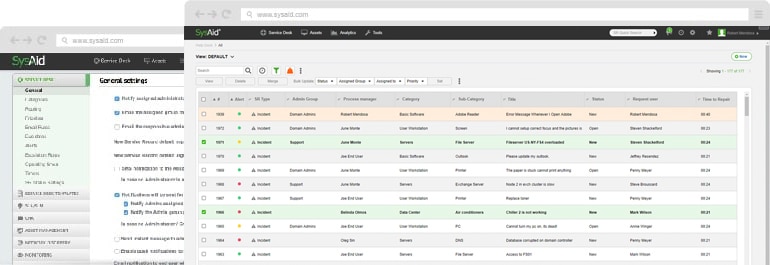
© 2020 SysAid Technologie. All rights reserved.
SysAid is IT inventory management software with help desk and asset management tools. For asset management purposes, SysAid scans to determine each asset on your network. It will then gather information on these assets, including the software installed on each and the hardware components (CPU, RAM, HDD, etc.).
You can also add hardware warranty, supplier, and maintenance information to each physical asset. Changes made to software or hardware components on the network are logged in an “asset activity log,” so you can review these changes.
For incident management purposes, the change log is useful for highlighting changes that may have caused problems further down the line. For each asset, you can view the service history to see if it has had a lot of incident reports and previous issues. You can also view all currently active tickets and resolved tickets. For issues recurring for one asset, you can flag those and create problem records using SysAid help desk tools. You can use the SysAid supplier catalog to manage the contracts and business relationships accompanying your assets. Each asset can be attached to the relevant supplier in the catalog, so you can easily purchase new assets or renew a license when it reaches its end of life.
You can also specifically track licenses—for example, to determine how many licenses have been purchased—and set up alerts to let you know when the number of installations exceeds the number of licenses you own. This can also help you to see when you have unused licenses costing you money unnecessarily. Finally, SysAid help desk tools include an automated ticket management process and a self-service portal, through which users can submit their tickets, chat with help desk staff, and track the history of their tickets. You can try SysAid for 30 days for free.
7. InvGate Assets
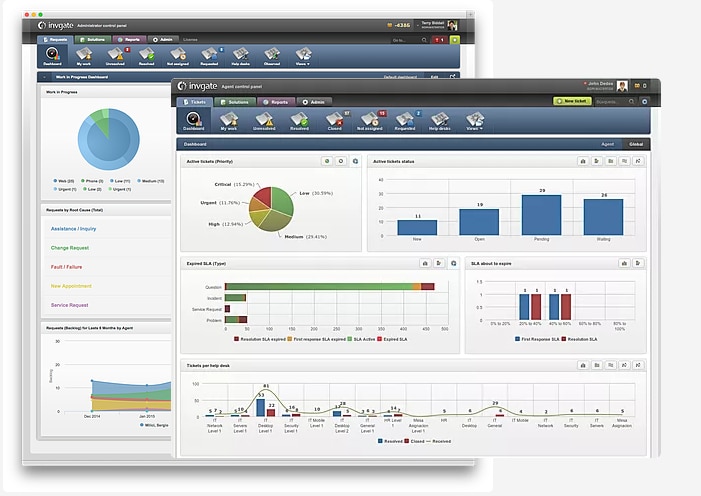
© 2020 InvGate. All rights reserved.
The final paid ITAM-dedicated tool on my list is InvGate Assets. This tool takes a centralized and automated approach to inventorying your assets, including IT hardware and software. It creates this inventory through network discovery utilities, agent-based discovery, and third-party sources.
In addition, InvGate Assets helps you to monitor changes to your asset base, including software, hardware, and licenses. Every modification is tracked in real time, which makes it easier to quickly spot any unauthorized or unexpected changes. The InvGate record of software licenses displays information on license expirations, allocation, and worth, which can help you to optimize and manage your software assets. You can make better purchasing and capacity-planning decisions when you have a clear picture of your licenses. Alongside this information, InvGate Assets provides details on your business contracts, including product lifecycles, warranties, and financial data.
Other useful features of InvGate Assets include remote desktop, network discovery, software metering (for showing software utilization), and software deployment. In addition to Assets, InvGate offers a tool called Insights, which has broader asset monitoring capabilities beyond ITAM. Whereas InvGate Assets helps you make the most of your IT investments, InvGate Insight extends to software normalization and laying the groundwork for a configuration management database. If you want a service or help desk solution, InvGate also offers a separate tool for that purpose. You can try InvGate Assets free for up to 30 days.
8. Spiceworks IT Asset Management
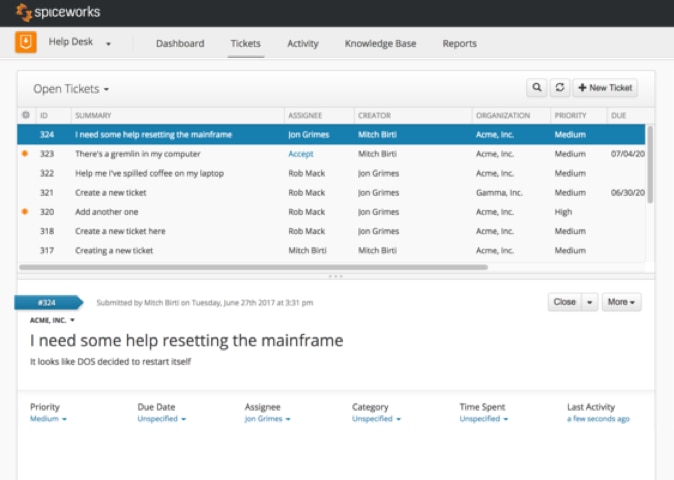
© 2020 Spiceworks. All rights reserved.
If you’re in the market for free asset management software, Spiceworks IT Asset Management software is a good option. Its three main functions are asset inventory, asset management, and reporting. In terms of creating an inventory, Spiceworks can use your network to discover your assets, then collect detailed information on them and put them into categories. This primarily applies to physical assets, such as workstations and servers, routers, switches, printers, and mobile devices.
Spiceworks includes a tool for checking software installations and licenses, which assists with auditing and alignment with compliance requirements. It can also detect and monitor your cloud services, allowing you to manage them all from one centralized place. The inventory of cloud services helps you to see which ones are being used. Finally, you can produce reports with Spiceworks. These can be quickly and easily generated and can be customized to fit with requirements or compliance audits.
A free tool can prove useful in many cases, especially for small businesses wanting to try out asset management functionality. However, in a large enterprise, you’ll need much greater functionality, likely necessitating a premium tool. Spiceworks IT Asset Management can be downloaded for free on the Spiceworks website.
Conclusion: The Best Asset Management Software
ITAM may not be particularly glamorous, but it plays a large role in important business functions and as a part of the broader ITSM process. Keeping tabs on your IT assets is vital for financial management, data security, software license management, and hardware capacity planning. Fortunately, a wide range of tools is available to help you perform IT asset management for your business or large enterprise.
My recommended tools are SolarWinds Web Help Desk or SolarWinds Service Desk, as either one can provide a comprehensive toolset to meet your ITAM solutions needs.
These asset management solutions easily link in with other SolarWinds tools through the Orion® Platform, enabling network and server monitoring, access rights management, and other IT management tasks. Both tools offer a fully functional free trial. Familiarize yourself with the list above to find a product that works for your business and reap the benefits of simplifying ITAM in your IT team.


